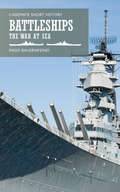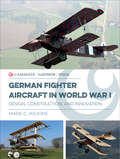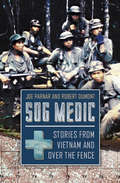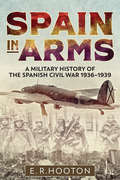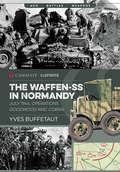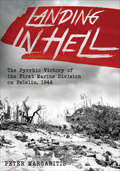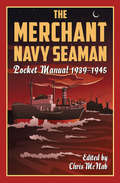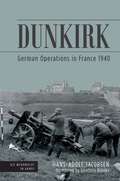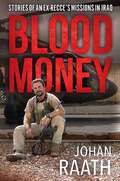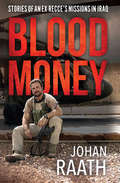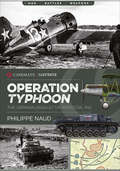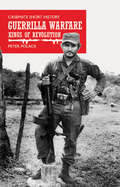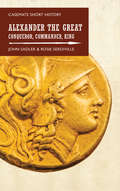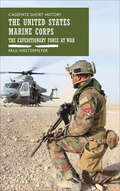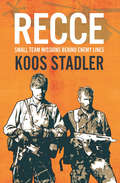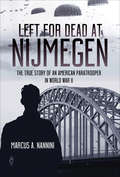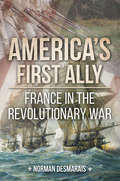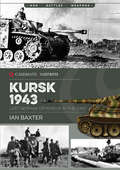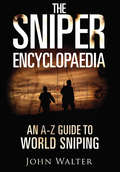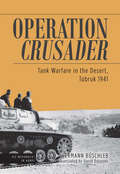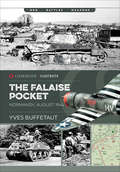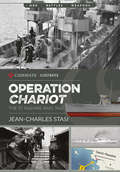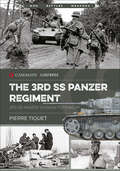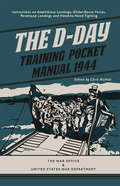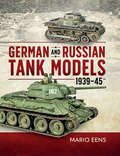- Table View
- List View
Battleships: The War at Sea (Casemate Short History)
by Ingo BauernfeindAn in-depth analysis of aircraft carrier battles in WWII and the evolution of carrier operations—from technology and strategy to life among the crew.First built in 1921, the aircraft carrier brought a new dimension to military strategy as the United States entered World War II. How Carriers Fought examines the evolution of carrier operations with a special focus on the conflict in the Pacific between the US Navy and the imperial Japanese fleet.Starting with a discussion of the tools and building blocks of carrier operations, historian Lars Celander then provides an analysis of various carrier battles to demonstrate how strategy and operations developed during the war. Every aspect of carrier warfare is covered, from navigation and communication technology to life inside the cockpit. A world of tactical dehydration and amphetamine pills is explored, as well as the measures pilots used to reduce their risk of death in the event of being hit.The major carrier battles of the war are considered, from Coral Sea and Leyte Gulf to the battle of Midway, where the Japanese decided to divide their forces while the Americans concentrated theirs. How Carriers Fought analyzes these tactics, exploring which worked best in theory and in practice.
German Fighter Aircraft in World War I: Design, Construction and Innovation (Casemate Illustrated Special #Ciss0002)
by Mark C. WilkinsThis fully illustrated volume explores German military aviation during WWI through archival photographs and authentically detailed replicas. Fighter aircraft were developed during World War I at an unprecedented rate, as nascent air forces sought to achieve and maintain air supremacy. German manufacturers innovated at top speed, while constantly scrutinizing the development of new enemy aircraft. The Germans also utilized the concept of modular engineering, which allowed them to disassembled or reassembled their aircraft quickly in the field. The pinnacle of their aeronautical innovations was the iconic Fokker D VII—the only aircraft specifically mentioned in the Treaty of Versailles, which forbade Germany from building it after the war. German Fighter Aircraft in World War I explores how German fighter aircraft were developed during the war, the advancements and trials that made the Fokker D VII possible, and the different makes and types of aircraft. Using unpublished images including photographs of surviving aircraft, archive images, and models and replicas, this volume shows details of aircraft that were kept top secret during the war. Extensively illustrated with 140 photos and ten color profiles, this is will be essential reading for all WWI aviation enthusiasts and modelers.
SOG Medic: Stories from Vietnam and Over the Fence
by Robert Dumont Joe ParnarThe “hair-raising details of the second-by-second events” of a Special Forces medic’s covert operations during the Vietnam War (On Point: The Journal of Army History Online).In the years since the Vietnam War, the elite unit known as the Studies and Observations Group (SOG) has spawned many myths, legends, and war stories. Special Forces medic Joe Parnar served with SOG during 1968 in FOB2/CCC near the tri-border region that gave them access to the forbidden areas of Laos and Cambodia. Parnar recounts his time with the recon men of this highly classified unit, as his job involved a unique combination of soldiering and lifesaving. His stories capture the extraordinary commitment made by all the men of SOG and reveal the special dedication of the medics, who put their own lives at risk to save the lives of their teammates. Parnar also discusses his medical training with the Special Forces.“A well-written, interesting account of Parnar’s three-year term of enlistment in the US Army, culminating as a Special Forces medic in Vietnam from 1968 to 1969 . . . Parnar takes the time to provide context, circumstance and motivation for heroism and tragedy—for US soldiers and the indigenous Vietnamese soldiers and civilians with whom he worked . . . The service, sacrifice and valor of a generation are vividly documented in the pages of SOG Medic.” —ARMY Magazine
Spain in Arms: A Military History of the Spanish Civil War, 1936–1939
by E. R. HootonSpain in Arms is a military history of the Spanish Civil War. It examines how the Spanish Civil War developed on the battlefield through the prism of eight campaigns between 1937-1939 and shows how many accounts of military operations during this conflict are based upon half-truths and propaganda. The book is based upon nearly 60 years of extensive research into the Spanish Civil War, augmented by information from specialized German, Italian and Russian works. The Italian campaign against the Basques on the Northern Front in 1937 was one of the most spectacular Nationalist successes of the Civil War, with 60,000 prisoners taken. This is also the first book to quote secret data about Italian air operations intercepted by the British. The figures intercepted by the British show the Italians flew 1,215 sorties and dropped 231 tons of bombs during the campaign, whilst also suffering the heaviest losses. It also demonstrates how the Nationalists won not simply by benefitting from a cornucopia of modern arms from the Fascist powers but by using its limited resources to maximum effect. Spain in Arms reveals the Nationalist battlefield superiority in terms of training and overall command, and the Republic's corresponding weaknesses in the same fields. The Republican Brunete and Belchite offensives of 1937 are described in detail, from the weapons they carried and the tactics they employed to the dynamic Nationalist response and reaction of the generals. This book also explores how the extent of foreign intervention on both sides has been greatly exaggerated throughout history and provides the first accurate information on this military intervention, using British and French archives to produce a radically different but more accurate account of the battles and the factors and men who shaped them. Hooton finally gives the historical context and operational implications of the battlefield events to provide a link between the First and Second World Wars.
The Waffen-SS in Normandy: July 1944, Operations Goodwood and Cobra (Casemate Illustrated #Cis0009)
by Yves BuffetautOne of the greatest paradoxes of the Battle of Normandy is that the German divisions found it much harder to reach the front line than the Allies, who had to cross the sea and then deploy in a cramped bridgehead until the American breakthrough of late July 1944. The Waffen-SS were no better off than the Heer units and German high command never quite got on top of operations, as the divisions were thrown into the melee one by one. During the month of June 1944, the Panzer divisions present succeeded in containing the Allies in a small bridgehead. In July, the arrival of more SS divisions should have finally allowed the Germans to counter-attack decisively. This was not the reality. The Allies had also strengthened in number and kept the blows coming, one after another. Each SS-Panzer division had a different experience of the fighting in July. This Casemate Illustrated looks at the divisions one by one throughout Operations Goodwood and Cobra which saw large tank battles and the collapse of the German front in Normandy. It includes over 100 photographs, alongside biographies of the commanders and color profiles of trucks and tanks which played a key role in operations as the Americans succeeded in breaking through the German line of defense.
Landing in Hell: The Pyrrhic Victory of the First Marine Division on Peleliu, 1944
by Peter MargaritisA detailed history and analysis of the most controversial amphibious operation in the Pacific during WWII: the Battle for Peleliu. On September 15, 1944, the United States invaded the tiny Pacific island of Peleliu, located at the southern end of the Palau Islands. Boasting a large airfield from which the Americans could mount bomber campaigns, Peleliu was a strategically essential part of Gen. MacArthur&’s long-awaited liberation of the Philippines. With the famed 1st Marine Division making the amphibious assault, Pacific High Command was confident that victory would be theirs in just a few days. They were drastically wrong. A mere week after landing, having sustained terrific losses in fierce combat, the 1st Marine Regiment was withdrawn. The entire division would be out of action for six months after sustaining the highest unit losses in Marine Corps history. This book analyzes the many things that went wrong in the Battle for Peleliu, and in doing so, corrects several earlier accounts of the campaign. It includes a comprehensive account of the presidential summit that determined the operation, details of how new weapons were deployed, a new enemy strategy, and command failure in what became the most controversial amphibious operation in the Pacific during WWII.
The Merchant Navy Seaman Pocket Manual 1939–1945 (The Pocket Manual Series)
by Chris McNabA view into the world of the intrepid but often forgotten seamen who helped the Allies win WWII. They may not have worn gold braid or medals, but the Allied Merchant Navies in World War II provided a vital service to their countries&’ war efforts. Hundreds of thousands of British and American sailors—some as young as fourteen—faced considerable risks to maintain an essential flow of armaments, equipment, and food: submarines, mines, armed raiders and destroyers, aircraft, kamikaze pilots, and the weather itself. Life on board a merchant ship could be tense, with hour after hour spent battling high seas, never knowing if a torpedo was about to hit. In the Arctic convoys, sailors had to cope with extreme cold and ice. But there was also comradeship and more open society than was the norm at the time, free of distinctions of class, race, religion, age, or color, and a mixture of nationalities, especially in the British fleet. The Merchant Navy Seaman Pocket Manual provides a fascinating glimpse into the world of these brave sailors, many of whom did not return. Drawing on documents, diagrams, and illustrations from British and American archives, it combines information on training, gunnery, convoys, and antisubmarine techniques with dramatic personal accounts. Covering the Battle of the Atlantic, the Arctic Convoys, and the Pacific, this book pitches the reader into the heart of this vital but often forgotten arena of WWII.
Dunkirk: German Operations in France, 1940 (Die Wehrmacht im Kampf)
by Hans-Adolf JacobsenThe German Army invaded France on 10 May 1940, and in just over ten days their rapid advance, led by three panzer corps, had left three French field armies, Belgian forces and the British Expeditionary Force with their backs to the sea, trapped along the northern coast of France. General Gort realized that evacuation was the only option, and so began a chaotic withdrawal towards the port of Dunkirk. While the Luftwaffe continued to attack pockets of Allied forces, the German ground forces were ordered to halt their advance on 22 May. These orders were changed four days later, but these crucial four days of inaction allowed the Allies time to retreat into Dunkirk and prepare a defensive perimeter. The fighting during the last days of May was desperate, with the remnants of the French First Army surrounded at Lille, holding off seven German divisions until finally forced to surrender, and the Belgian Army forced to capitulate to the east of Dunkirk. Though the cost was devastatingly high, Dunkirk was held long enough for over 300,000 Allied troops to be evacuated back to England, with the remainder of the rearguard of French troops surrendering on 4 June. The British narrative of the retreat and evacuation that prompted perhaps Winston Churchill's most famous wartime speech has always been well-known; however only now is Hans-Adolf Jacobsen's detailed account of the battle from the German perspective available in English.
Blood Money: Stories Of An Ex-Recce's Missions In Iraq
by Johan Raath‘I remember the cracking sound of the AK-47 bullets as they tore through our windscreen . . . A piece of bullet struck my bulletproof vest in the chest area and another piece broke off and lodged in my left forearm.’ <P><P> Johan Raath and a security team were ambushed in May 2004 while on a mission to reconnoitre a power plant south of Baghdad for an American firm. He had been in the country for only two weeks. This was a taste of what was to come over the next few years as he worked as a private military contractor (PMC) in Iraq. <P><P> His mission? Not to wage war but to protect lives. Raath and his team provided security for engineers working on reconstruction projects in Iraq. Whether in the notorious Triangle of Death, in the deadly area around Ramadi or in the faction-ridden Basra, Raath had numerous hair-raising experiences. <P><P> Key to his survival was his training as a Special Forces operator, or Recce. <P><P> This riveting account offers a rare glimpse into the world of private military contractors and the realities of everyday life in one of the world’s most violent conflict zones.
Blood Money: Stories of an Ex-Recce's Missions in Iraq
by Johan RaathA former Special Forces soldier—and presidential bodyguard—shares heart-stopping stories of his time as a private military contractor in Iraq.“I remember the cracking sound of the AK-47 bullets as they tore through our windscreen . . . A piece of bullet struck my bulletproof vest in the chest area and another piece broke off and lodged in my left forearm.”Johan Raath and a security team were ambushed in May 2004 while on a mission to reconnoiter a power plant south of Baghdad for an American firm. He had been in the country for only two weeks. This was a taste of what was to come over the next few years as he worked as a private military contractor (PMC) in Iraq.His mission? Not to wage war, but to protect lives. Raath and his team provided security for engineers working on reconstruction projects in Iraq. Whether in the notorious Triangle of Death, in the deadly area around Ramadi, or in the faction-ridden Basra, Raath had numerous hair-raising experiences.Key to his survival was his training as a Special Forces operator, or Recce.This riveting account offers a rare glimpse into the world of private military contractors and the realities of everyday life in one of the world’s most violent conflict zones.
Operation Typhoon: The German Assault on Moscow, 1941 (Casemate Illustrated)
by Philippe NaudA visual look at the Nazi assault on the Soviet capital in the series that&’s &“a welcome addition . . . targeted at the general World War II enthusiast&” (Globe at War). After the initial successes of Operation Barbarossa, at the end of September 1941, Hitler turned his focus to Moscow, with the unshakeable belief that capturing the capital would knock the Soviets out of the war. On the face of it, it was an unequal matchup in Germany&’s favor, but the picture was, in fact, a great deal more complex; the Germans had suffered very significant losses since the invasion of Russia had begun and had issues with logistics and air support. The Soviets, under the command of Gen. Zhukov, were beginning to be better supplied with reinforcements and were prepared to defend to the death. This volume in the Casemate Illustrated series concentrates on the main German assault of October 1941. Guderian&’s panzer divisions at first made sweeping gains, as they had done so many times before, and large parts of the Red Army were encircled at Vyazma and Bryansk. These successes allowed the Soviets time to regroup, as the encircled armies did not surrender and had to be dealt with. Then, three engagements followed at Mtsensk, Maloyaroslavets and the Mojaisk defense line that proved that the war in the east was not entering its final days, as German high command believed. Illustrated with over 150 photographs, plus profile drawings of tanks, vehicles, and aircraft, this book gives a vivid impression of the situation for both protagonists, and a detailed analysis of the critical days as the fate of Moscow—and perhaps the whole war—hung in the balance.
Guerrilla Warfare: Kings of Revolution (Casemate Short History)
by Peter PolackThis concise history of guerilla warfare presents profiles in combat courage from George Washington to Simón Bolívar, Mao Zedong, and beyond. The concept of guerrilla warfare is centuries old, with Sun Tzu&’s writing on the subject dating back to the sixth century BC. One of the earliest recorded examples of guerrilla tactics deployed by a military leader was the campaign of Roman general Fabius Maximus, who took a course of evasion and harassment against Hannibal&’s columns. Guerilla Warfare is a compendium of prominent guerrilla leaders across the globe, from thirteenth-century Scotland&’s William Wallace to modern-day Sri Lanka&’s Velupillai Prabhakaran. It profiles each leader to analyze their personal history, military tactics, and political strategy. All are home-grown leaders of extended guerrilla campaigns. Many became the first leaders of their liberated countries. Both victories and defeats are included here in an analysis of effective guerrilla tactics as well as counterinsurgency strategies. Today, the labels of insurgent, freedom fighter, and jihadi are fast replacing guerrilla. The old notion of the guerrilla, associated with fights for independence and the end of colonialization, has dimmed with modern and far-reaching religious insurgencies taking their place. This concise history gives a fascinating overview of a once history-altering form of warfare.
Alexander the Great: Conqueror, Commander, King (Casemate Short History)
by John Sadler Rosie SerdivilleAn overview of Alexander&’s life—from his early military exploits to the creation of his empire and the legacy left after his premature death. Alexander was perhaps the greatest conquering general in history. In a dozen years, Alexander took the whole of Asia Minor and Egypt, destroyed the once mighty Persian Empire, and pushed his army eastwards as far as the Indus. No one in history has equaled his achievement. Much of Alexander&’s success can be traced to the Macedonian phalanx, a close-ordered battle formation of sarissa-wielding infantry that proved itself a war-winning weapon. The army Alexander inherited from his father was the most powerful in Greece—highly disciplined, trained, and loyal only to the king. United in a single purpose, they fought as one. Cavalry was also of crucial importance in the Macedonian army as the driving force to attack the flanks of the enemy in battle. A talented commander able to anticipate how his opponent would think, Alexander understood how to commit his forces to devastating effect and was never defeated in battle. He also developed a corps of engineers that utilized catapults and siege towers against enemy fortifications. Alexander led from the front, fighting with his men, eating with them, refusing water when there was not enough, and his men would quite literally follow him to the ends of the (known) world. None of his successors were able to hold together the empire he had forged. Although he died an early death, his fame and glory persist to this day.
The United States Marine Corps: The Expeditionary Force at War (Casemate Short History)
by Paul WestermeyerA concise overview of USMC history from an award-winning author, including photos and a timeline: &“Educational and enjoyable.&” —Booklist Many think of the United States Marine Corps as a second land army, and while it has been employed in that capacity, it is foremost a naval expeditionary force able to seize, secure, and defend advanced naval bases in support of major campaigns. The Corps dates back to the Revolutionary War, but while they served in the conflicts of the nineteenth century, they are famed for their part in the wars of the twentieth century. On the Western Front in World War I they were blooded at Belleau Wood. Between the wars the Corps developed amphibious tactics that were employed to great effect during the Pacific island campaigns during World War II, including the infamous battles of Peleliu, Iwo Jima, and Okinawa. The name of the Corps is forever entwined with the battles of Inchon and Chosin Reservoir in Korea, and Hue and Khe Sanh in Vietnam. The US Marines have continued their expeditionary role to this day, undertaking not only combat operations but also peacekeeping, peace enforcement, humanitarian relief, and short-notification/limited-duration contingency operations. This short history charts the evolution of the Corps as it has adapted to changing combat over two centuries.
Recce: Small Team Missions Behind Enemy Lines
by Koos StadlerA gripping firsthand account of life and combat operations in the elite South African Special Forces, known as Recces, by a veteran Recce officer. The South African Special Forces are one of the most effective—and mysterious—military units in the world. Working in secret on covert operations, the legendary Recces have long fascinated, but little is known about how they operate. Now Koos Stadler, a career officer in the South African Special Forces, shares a revealing chronicle of his life and his experiences in the Border War. Shortly after passing the grueling Special Forces selection course in the early 1980s, Koos Stadler joined the so-called Small Teams group at 5 Reconnaissance Regiment. This sub-unit was made up of two-man teams and was responsible for many secret missions behind enemy lines. Sent to blow up railway lines and enemy fighter jets in south Angola, Stadler and his partner stared death in the face many times.
Left for Dead at Nijmegen: The True Story of an American Paratrooper in World War II (Casemate Illustrated)
by Marcus A. NanniniLeft for Dead at Nijmegen recalls the larger-than-life experiences of an American paratrooper, Gene Metcalfe, who served in the 82nd Airborne during WWII. From his recruitment into the military at Camp Grant to his training with the 501st Paratroop Infantry Regiment at Camp Toccoa, it wasn't until D-Day itself that he first arrived in England to join the 508th PIR. When Metcalfe boarded the C-47 which would drop him at Groesbeek Heights, just outside of Nijmegen, Holland, he was handed a box of twelve dozen condoms by an over-confident British lieutenant. He was to be among the first to jump into what should have been a picture-book meadow, free of German troops. Instead, it was defended by three German anti-aircraft cannon emplacements. As he jumped into a hail of bullets and exploding shells he watched his plane roll over and plummet into the ground. It was at that moment he realized the condoms had either been a bad joke or the planners of Operation Market Garden had seriously underestimated German resistance. Gene was listed as KIA and left for dead by his patrol, who presumed the worst when they saw his injuries from a shell explosion. The rest of his story is equally gripping, as he became a POW held outside Munich, being moved between various camps ridden with disease and a severely undernourished population. Eventually, after making an escape attempt and being captured within sight of the snow-capped Swiss mountains, his camp was liberated by American troops in April 1945. Gene's story is both remarkable for his highly unusual encounter, and his subsequent experiences.
America's First Ally: France in the Revolutionary War (The Pocket Manual Series)
by Norman Desmarais<p>The Revolutionary War historian provides “a comprehensive and accessible guide” to the vital influence France had on America’s path to independence (Publishers Weekly).<p> <p>French support for United States independence was both vital and varied, ranging from ideological inspiration to financial and military support. In this study, historian Norman Desmarais offers an in-depth analysis of this crucial relationship, exploring whether America could have won its independence without its first ally.<p> <p>Demarais begins with the contributions of French Enlightenment thinkers who provided the intellectual frameworks for the American and French revolutions. He then covers the many forms of aid provided by France during the Revolutionary War, including the contributions of individual French officers and troops, as well as covert aid provided before the war began. France also provided naval assistance, particularly to the American privateers who harassed British shipping. Detailed accounts drawn from ships’ logs, court and auction records, newspapers, letters, diaries, journals, and pension applications.<p> <p>In a more sweeping analysis, Desmarais explores the international nature of a war which some consider the first world war. When France and Spain entered the conflict, they fought the Crown forces in their respective areas of economic interest. In addition to the engagements in the Atlantic Ocean, along the American and European coasts and in the West Indies, there are accounts of action in India and the East Indies, South America and Africa.<p>
Kursk 1943: Last German Offensive in the East (Casemate Illustrated #Cis0014)
by Ian BaxterAn illustrated history of World War II&’s largest tank battle that went down near the Russian city. In the summer of 1943, Nazi Germany launched Operation Zitadelle (Citadel), aimed at cutting off Soviet forces in the Kursk salient. This offensive resulted in the Battle of Kursk. Kursk quickly became a fierce contest of attrition, as Wehrmacht and elite Waffen-SS Panzer-Divisions with their powerful Tiger and Panther tanks unsuccessfully tried to hammer their way through the intricate lines of strong Soviet defensive positions. What followed was unabated fighting for two weeks as German units were slowly and systematically ground down in a series of brutal armored battles. During this ferocious fighting the Red Army savagely contested every foot of ground, finally ending German invincibility forever. For the first time in its short history, the blitzkrieg concept had failed. The reverberations caused by the defeat at Kursk were immense, and never again did the German war machine go on the offensive in the East. Stiff defensive action was now the stratagem placed upon the dwindling Panzerwaffe right to the gates of Berlin. With comprehensive captions and text, Kursk 1943 tells the story of this dramatic battle using rare and unpublished photographs, maps, and highly detailed artist profiles. The book reveals the events leading up to the battle in the first half of 1943 and the buildup of forces by both sides before their climatic showdown at Kursk.
The Sniper Encyclopaedia: An A–Z Guide to World Sniping
by John WalterThe Sniper Encyclopaedia is an indispensable alphabetical, topic-by-topic guide to a fascinating subject. This is a comprehensive work that covers virtually any aspect of sniping. The work contains personal details of hundreds of snipers, including not only the best-known — world renowned gurus such as Vasiliy Zaytsev and Chris Kyle — but also many crack shots overlooked by history. Among them are some of more than a thousand Red Army snipers — men and a surprising number of women, who amassed sufficient kills to be awarded the Medal for Courage and, later, the Order of Glory. Some of the best-known victims of snipers are identified, and the veracity of the most popular myths is explored. The book pays special attention to the history and development of the many specialist sniper rifles — some more successful than others — that have served the world’s armies since the American Wars of the nineteenth century to today’s technology-based conflicts. Attention, too, is paid to the progress made with ammunition — without which, of course, precision shooting would be impossible. The development of aids and accessories, from camouflage clothing to laser rangefinders, is also considered. Finally, The Sniper Encyclopaedia examines significant locations and specific campaigns — the way marksman have influenced the course of the individual battles and places which have played a crucial part in the history of sniping, from individual sites to sniper schools and training grounds. The book contains authors’ biographies, a critical assessment of the many books and memoirs on the world of the sniper, and a guide to research techniques.
Operation Crusader: Tank Warfare in the Desert, Tobruk 1941 (Die Wehrmacht im Kampf)
by Hermann BuschlebA 1960s German perspective of the World War II battle in Libya and how the Allied and Axis commanders shaped the course of the action. The port city of Tobruk, Libya, was besieged by German and Italian forces in April, 1941. Following an abortive attempt in June, the Allies made a second attempt in late November, when the Eighth Army launched Operation Crusader, aimed at destroying the Axis armored force then advancing. After several inconclusive engagements, the British 7th Armoured Division was defeated by the Afrika Korps at Sidi Rezegh. Erwin Rommel was then forced to withdraw his troops to the defensive line at Gazala, making the operation the first Allied victory over German land forces in World War II. This account of the tank warfare during Operation Crusader in front of Tobruk in the fall of 1941 examines the roles of commanders in the battles of Operation Crusader, in particular the part of Rommel, who achieved some defensive successes during combat. As well as examining the part of commanders, it discusses the parameters of the battle: the terrain, weather, visibility, logistics, intelligence, and the forces involved. It then narrates the course of the battle, and the result.
The Falaise Pocket: Normandy, August 1944 (Casemate Illustrated #Cis0010)
by Yves BuffetautThe battle of the Falaise Pocket, in August 1944, was the turning point in the Normandy campaign. By early August the German Army was in turmoil: while it was managing to hold back the Allies, the defense involved resources that could not be replaced, and the Allies ruled the skies above. In late July, American troops broke through the American lines and pushed south and east, while British and Canadian troops pushed south. Although unable to counter these offensives, Hitler refused to permit the commander Army Group B, Field Marshal von Kluge, to withdraw. Instead he was ordered to launch a counteroffensive at Mortain, the result being that the Germans ended up further into the Allied envelopment. On 8 August Montgomery ordered that the Allied armies converge on the Falaise area—by 21 August the Allies had linked up and sealed the pocket, trapping around 50,000 Germans inside. While many soldiers did eventually escape the encirclement, the losses were catastrophic and by the end of the month Army Group B had retreated across the Seine, ending the battle of Normandy. This illustrated account examines the battle from the failed offensive at Mortain, looking at both German and Allied perspectives, using maps, diagrams and profiles to complete the story.
Operation Chariot: The St Nazaire Raid, 1942 (Casemate Illustrated #Cis0013)
by Jean-Charles StasiAn illustrated history of the World War II British amphibious attack on a dry dock in the German-occupied French town. At the beginning of 1942, the prospect of Germany&’s Tirpitz, the heaviest battleship ever built by a European navy, patrolling the Atlantic posed a huge threat to the convoys that were the lifeline for Britain. Bombing raids to destroy the ship failed. A more radical plan was conceived to destroy the dry-dock facility at St Nazaire on the French Atlantic coast. Without the use of the only suitable base for the ship, the threat would be neutralized. The plan was to ram the entrance gates with a ship packed with explosives on a delayed fuse. A motorboat armed with torpedoes would fire at the inner gate causing further damage to submarine pens. The troops and crew would then destroy as many dockyard targets as they could and withdraw in fast motor launches that had followed them in. All this was to be achieved under cover of an air raid. HMS Campbeltown, a U.S. lend-lease destroyer, was chosen for the task. On the night of March 27, the raid commenced. The Campbeltown succeeded in lodging its bows in the outer gates. The fuses detonated the explosives in its hold the following day. The dock gates were destroyed. The cost to the Allies was high, but the Tirpitz was never able to leave Norwegian waters. This volume in the Casemate Illustrated series gives a clear overview of the planning and execution of the raid and its aftermath, accompanied by 125 photographs and images, including color profiles and maps.
The 3rd SS Panzer Regiment: 3rd SS Panzer Division Totenkopf (Casemate Illustrated #Cis0011)
by Pierre Tiquet“A fascinating look into the experiences of the men of an elite armored unit that fought on the Eastern Front, written essentially in their own words.” —AMPSThe 3rd SS Panzer Regiment was part of the Totenkopf Division—one of the thirty-eight Waffen-SS divisions active during World War II. Notorious for its brutality, most notably a mass execution of British prisoners in the Battle of France, Totenkopf had a fearsome reputation. The 3rd SS Panzer Regiment was formed in France in late 1942, and transferred to the Eastern Front in early 1943, where it fought for the rest of the war.The regiment participated in a number of battles, and would be reduced and rebuilt a number of times. The panzers of 3rd SS Panzer Regiment fought at Kharkov, took part in Operation Citadel, fought in the battle of Krivoi Rog, and the relief of the Korsun Pocket. The regiment then retreated over the Dniester. They fought in Poland against the Russian advance, before being moved to Hungary where they participated in the attempt to relieve Budapest. They eventually surrendered in Czechoslovakia to the 11th US Armored Division.This book tells the story of the 3rd SS Panzer Regiment through the words of the veterans themselves. Among the veterans whose accounts are included are Walter Weber, a member of a tank crew in 5. Kompanie who recounts their optimism and high spirits at the start of Operation Citadel as the Germans made initial advances, followed by retreat as winter set in and the Russians began to push them back. Unterscharführer Stettner recalls the fierce tank battles and the difficulties advancing across minefields and evading an often well-concealed foe. Corporal Fritz Edelmann records the attempts to relieve Budapest in 1945 that Totenkopf took part in, which ended in encirclement, defeat and surrender to the Americans on May 9, 1945. In addition, it is illustrated with a wealth of contemporary photographs, original documents, and artifacts.
The D-Day Training Pocket Manual, 1944: Instructions on Amphibious Landings, Glider-Borne Forces, Paratroop Landings and Hand-to-Hand Fighting (The\pocket Manual Ser.)
by Chris McNabThe success of the D-Day landings on June 6, 1944 depended on thousands of troops carrying out their mission and the seamless coordination of the amphibious landings with paratrooper and glider assaults. The troops not only had to be trained up ready for their own roles, but to work alongside other troops, often coordinating activities and communicating with other troops while in unfamiliar terrain and under fire. This pocket manual brings together excerpts from Allied manuals used in the preparation for D-Day, including amphibious landings and managing beachheads, pathfinder, paratrooper and glider pilot training, and infantry and armored fighting in the bocage countryside.
German and Russian Tank Models, 1939–45
by Mario EensThis fully illustrated guide offers step-by-step instructions for building detailed models of German and Russian WWII tanks. This comprehensive guide is invaluable for tank modelers of all skill levels. It includes tips and techniques for building models scaled at 1/72, 1/48 and 1/35. Expert modeler Mario Eens also provides a wealth of information on the tools, paints and techniques needed to give your models an accurate and realistic finish. With this guide at your side, you&’ll be able to recreate the Russian T-34 at the time of the battle of Kursk, and the Su-152 in winter camouflage, as well as the German Panzer I in North Africa, and the gigantic Maus, as it might have appeared just after the war ended.
